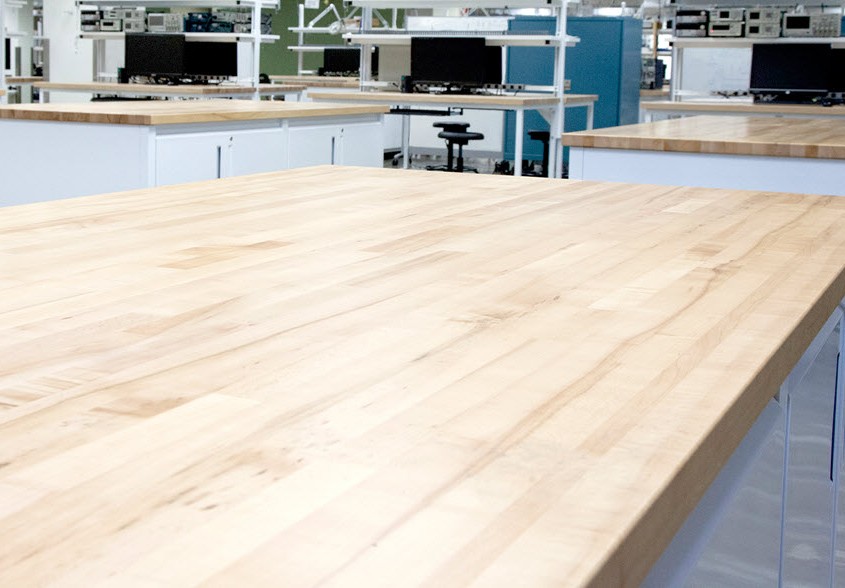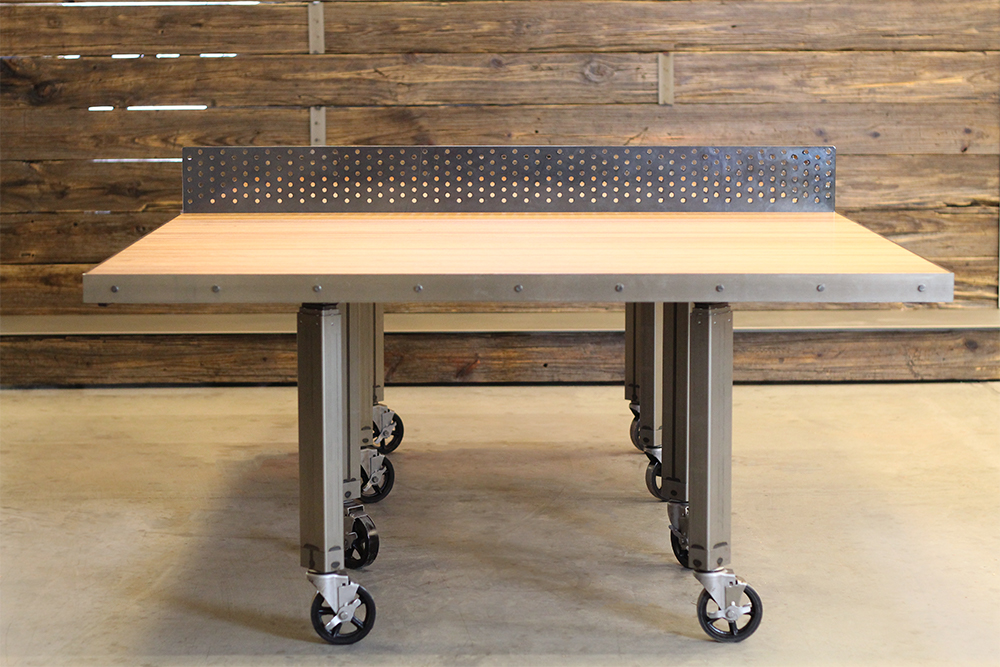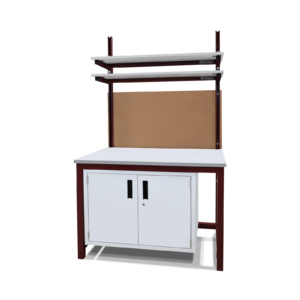Looking for the beauty and durability of top quality solid American hardwood countertops? You’ve come to the right place.
As an American heritage manufacturer of industrial-grade furniture, Formaspace offers a full line of custom, solid wood countertop desks, tables, and workstations — built just for you at our factory headquarters in Austin, Texas — with the authentic, industrial look that you’ve been looking for.
Choose the Right Hardwood for your Solid Wood Work Surface Furniture
If you haven’t picked up on it already, Formaspace offers you the widest possible choice in furniture customization, from specifying materials and finishes to crafting one-of-a-kind, fully bespoke signature designs you’ll never see twice.
When specifying industrial-look furniture with solid wood work surfaces, one of the major decisions is your choice of hardwood. Understandably, you may have a preference already, or want to match the look of existing furniture. But if you’re not sure which type of wood to select, have a glance at our wood species checklist below to help guide you in a decision. We also recommend speaking with one of our Formaspace Design Consultants who will be happy to discuss your options — including sourcing other species, including exotics, or using wood materials that you provide to incorporate into your furniture order. Just fill out the quick contact form at the end of this article to make contact.
- Solid Hard Rock Maple Countertops
Known variously as hard, rock, black or sugar maple, this group of closely related hardwood species is known for its durability (unlike the soft maple species). Hard maple’s lighter color sapwood is commonly used for solid wood work surfaces; the grain is generally fine and straight with a very light white to off-white cream color. Thanks to its inherent anti-bacterial properties, hard maple wood is often used in commercial kitchen countertops, kitchen islands and prep stations, as well as butcher block cutting boards and chopping blocks. For commercial kitchens and other food manufacturing facilities requiring sanitary conditions, we offer NSF certified butcher block countertops crafted from solid hard maple. - Solid Black Walnut Countertops
Long prized for use in premium cabinet-making as well as rifle production, walnut is known for its rich, lustrous finish, easy workability, inherent stability and shock resistance (an important characteristic for rifle stock!). Black walnut generally has a fine, straight wood grain. As the heartwood tends to be darker than the sapwood, a commercial steaming process is often employed during processing at the sawmill to even out color transitions. Solid walnut wood countertops are an excellent choice when you want to make a traditional, authentic design statement for your furniture project. - Solid Red Oak Countertops
Characterized by the natural reddish-brown color of its heartwood, red oak is a traditional choice that adds warmth and character to high-end custom kitchens and open plan offices alike. While the grain of red oak is straight, its texture is generally coarser than other wood species; this, in combination with prominent “rays” (the series of short dark lines that flow along the grain), gives the red oak its characteristic natural feel. Like the other hardwoods, red oak* is an exceptionally strong material that’s used where durability is important (such as red oak kitchen countertops and hardwood flooring, for example).*White oak is also available upon request. Ask your Formaspace Design Consultant for details. - Solid Black Cherry Countertops
A favorite choice for furniture and musical instrument makers, black cherry is a hardwood known for its reddish, brown heartwood. Today, black cherry is often used in creating modern Mission and Shaker furniture pieces, which could be a consideration if you want matching hardwood countertops. Exposure to the sun can darken black cherry’s color over time. The grain pattern can vary from straight to curly, depending on the stock selection. - Solid Hickory Countertops
An exceptionally strong wood, hickory is known for its use in fashioning traditional products out of wood, such as ax handles, drumsticks, ladder rungs, or hockey sticks, where added toughness is required. Depending on the stock selection, hickory can vary in appearance. Hickory sapwood is lighter in color and can change to a pale gray over time. Heartwood hickory has a paler brown to reddish tone. If you are looking for a more rustic look, specify hickory stock with bird-peck or bark inclusions. - Solid African Mahogany Countertops
After years of over-harvesting, American mahogany is no longer commercially available. (Harvesting is protected by an international treaty.) However, there are species from West Africa in the same botanical family, such as Khaya ivorensis, that are available and can serve as a suitable substitute. This species of African mahogany, known as khaya for short, is exceptionally durable and workable. Better cuts of khaya heartwood have a deep red color, while the sapwood is lighter in color. Careful quarter sawing of khaya stock can reveal highly attractive “ribbon” stripes.
(As an aside, we don’t offer pine or other softwood species — unless you request it for some reason — as softwood materials don’t meet our high standards for service life longevity; N.B. all Formaspace furniture is backed by a 12-year no-questions-asked guarantee.)
Solid Hardwood Countertops for Your Office, Commercial-Grade Kitchen, Craft Room or Workshop
Like fashion, design trends come and go. But here at Formaspace, we take the long view, confident that our industrial grade products will stand the test of time. That’s why we’re enthusiastic about recommending classic design elements, such as solid wood countertops. Whether you are creating a modern office with an industrial look-and-feel or a commercial-grade kitchen, natural solid wood materials lend a timeless, natural feel to any interior environment.
For example, careful selection of the right wood species and surface finishes can warm an interior and help bring the outdoors indoors. Wood surfaces can also evoke an authentic, industrial heritage feel. And, as you use the wood surfaces, the patina that develops further enhances its genuine character; unlike other cheaper materials, which may simply look ‘worn out’ after extended use, solid wood countertops are long-lasting and durable, making them an ideal choice for:
Office Furniture: Solid wood makes a great statement when used as tops for tables, benches, computer workstations, conference and dining tables.
Commercial-Grade Kitchens and Employee Break Rooms: Solid wood is an ideal material for creating custom counters, islands, and prep stations in commercial-grade kitchens. Solid hard maple countertops and butcher block cutting surfaces are available with NSF certification for restaurants and food preparation facilities. Solid wood is also a durable and welcoming choice for employee eating areas and break rooms.
Craft Rooms: When it’s time to create your dream workspace for your home-based business or hobby activities, the durability and warmth of solid wood work surfaces will give you pride of ownership for years to come.
Workshop: Traditional workshops use solid wood countertops for a reason: they are strong, durable, and pleasant to work on. They also help inspire the imagination by connecting us to the long tradition of American craftsmanship.
Learn How Solid Wood Countertops and Butcher Block Countertops are Made
When you think of traditional wood countertops, there are two main categories: the standard Edge Grain category, where the wood runs horizontally from end-to-end, and butcher block countertops (also known as End Grain), which are easily identified by their characteristic checkerboard pattern.
Let’s talk about the standard Edge Grain category first.
It’s considered rare today for solid wood countertops to be constructed from one or two solid wood pieces. Unless you are creating exceptional pieces made from an entire log, the wood stocks generally available today aren’t wide enough. (You might see furniture like this in a museum made by pioneers who had access to first growth forests.) That’s actually OK because the modern way of constructing wood countertops out of individual pieces (known in the trade as “rails”) provides a stronger, more durable, and smoother work surface that is much less likely to warp or split.
Carefully dried and seasoned pieces of wood are hand selected then assembled together using pressure and proprietary gluing processes to “cure” them into a solid material. The result is a product where the edge of the grain is exposed across the surface, hence the term Edge Grain countertops. After the pressurized gluing process is completed, the countertop is planed, and a protective surface treatment is applied. Depending on your preference, this might be the final finish or an intermediate one that allows the final surface treatment to be completed on site.
The standard approach for creating Edge Grain countertops is to use full-length rails of wood, e.g. stock that is as long as the final product is wide. However, it’s also possible to create solid wood countertops using shorter pieces that are laid out in what resembles a brick pattern. This technique, known as a blended wood countertop, can be more visually interesting. It can also be more economical, as it utilizes available wood stock of varying lengths. (The outer sections of blended countertops are customarily made of wood rails that are full width to avoid seams at the outside edges.)
On the other hand, butcher block countertops are the classic End Grain example; they are created by piecing together the wood stock vertically, in a checkerboard pattern, where the end grain is pointing upwards (rather than toward the sides). Why is it assembled this way? The answer lies in the way that kitchen knives interact with the end grain. When you are cutting or chopping, the impact of the knife blade is cushioned as it impacts the end grain fibers of the wood. These wood end grain fibers split apart slightly to absorb the cut. The result is a smooth wood surface with less wear and tear on the knives.
Why Solid Wood Countertops are an Environmentally-Friendly and Sustainable Choice
We take environmental stewardship seriously at Formaspace. As we’ve alluded to already, one species, American mahogany, has become unavailable due to over-harvesting. It’s important that we all use natural, renewable resources responsibly.
With careful resource management, wood is an environmentally-friendly choice. Here are some of the considerations and efforts we make to ensure your solid wood countertops are a material that you can feel good about:
- We source lumber from sustainable forest programs. We do not supply endangered wood species, such as Ash.
- Smaller pieces are used to create butcher block countertops.
- Sawdust is recovered in order to heat the kilns that are used to dry lumber.
Making the Right Color Choice for Solid Wood Work Surfaces
As a natural product, solid wood countertops can develop a wonderful patina as they age.
The tone of the wood color can also change over time — making this an important consideration when choosing a wood stock. The general rule of thumb is that, when exposed to light over a long period of time, the lighter color woods will become lighter (e.g. more bleached), while the dark woods (black walnut and black cherry in particular) will tend to become darker in tone.
The bottom line: sun exposure can change the color of wood over time, independently of its finish treatment. Strong sunlight exposure can even create darker or lighter areas underneath objects that are rarely moved (example, a lamp or a container) so be aware. Keep direct sun exposure even and move items on the wood surface around from time to time.
How to Maintain Solid Wood Work Surfaces and Butcher Block Countertops
In order to provide you with succinct instructions on how to maintain solid wood countertops, we will divide the world into two categories: 1) conventional use and 2) food preparation use.
Maintenance and Care of Wood Countertops in Conventional Use
The first tip is to avoid water: don’t let wood countertops stay wet for an extended period of time as this can stain the surface and penetrate deep into the glue joints.
As we mentioned above, it’s also important to control intense sunlight exposure to prevent unwanted color changes.
If your countertop never sees food preparation use, you can specify a polyurethane or other synthetic finish applied here at the factory. Otherwise, you can treat the surface with appropriate protective products. For non-food grade applications, you can apply mineral oils designed for solid wood surfaces. If you are using the solid wood surfaces in a food-safe environment, it’s important to create a protective surface by first applying a food-grade wood oil followed by an application of food-grade protective cream on a regular basis. Your Formaspace Design Consultant can make product specific recommendations tailored to your individual furniture specifications.
It’s OK to occasionally sponge wash the countertops with mild soapy water and periodically sanitize them with a weak bleach solution. Rinse and dry after cleaning. Countertops that have not been sealed with a polyurethane or other synthetic finish will need a fresh application of whichever protective oil or cream product you are using.
Maintenance and Care of Wood Countertops in Food Preparation Use
Using proper food safety protocols is critical for avoiding contamination in commercial food preparation settings.
It’s considered good practice to segregate work areas; for example, dedicate one station to vegetable preparation, while maintaining separate, dedicated stations for meat, fish, seafood, or poultry.
Generally, the most intensive food preparation (involving cutting and trimming) will take place on butcher block countertops.
Prior to initial use, treat the surface with a food-safe wood oil followed by a protective cream, such as products that contain beeswax, which helps maintain a protective barrier that helps the wood retain its protective oils while keeping the liquid from entering the joints. (Your Formaspace Design Consultant can recommend brand name products that are suitable for your specific application.)
The steps above are especially important when cutting fish or poultry on the work surface. Improper surface preparation can lead to cross-contamination.
Keep exposure to liquids at a minimum; don’t place fresh meats on wood countertops for an extended period of time — use them or remove them. Use a steel scraper (never a steel brush) to remove liquid build up. Also, don’t use your wood countertop surfaces as a place to clean and dry your knives and kitchen utensils, use the sink and a drying rack.
Avoid cutting on the same area of the countertop to reduce wear. Avoid using cleavers with razor sharp cutting edges, use a dull sharpened edge instead.
Turn to Formaspace for the Best Selection of Highest-Quality Wood Countertops
If you want the highest-quality wood countertop furniture, you’ve come to the right place.

When you buy one of our products, you’ll be sure it will last for years and years. If you spend money on an inferior product, you’ll be dissatisfied and end up paying twice: once to buy it and once again to replace it when it wears out prematurely.
Speak with one of our friendly Formaspace Design Consultants who can help you specify just the right product for you, one that you’ll be happy with for many years to come.
All our solid wood furniture products are made from top quality stock that’s carefully hand selected. Master craftsmen (and women) assemble your product to your exact specifications at our factory headquarters in Austin, Texas.
Take the next step. Fill out the quick contact form below. You’ll be glad you did.













